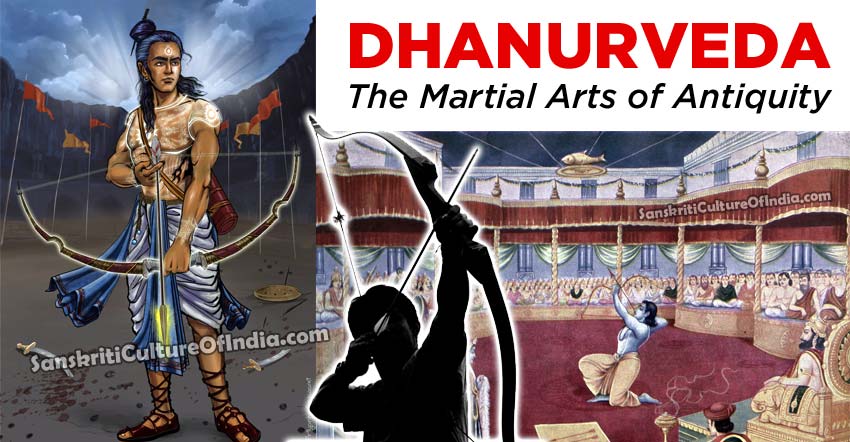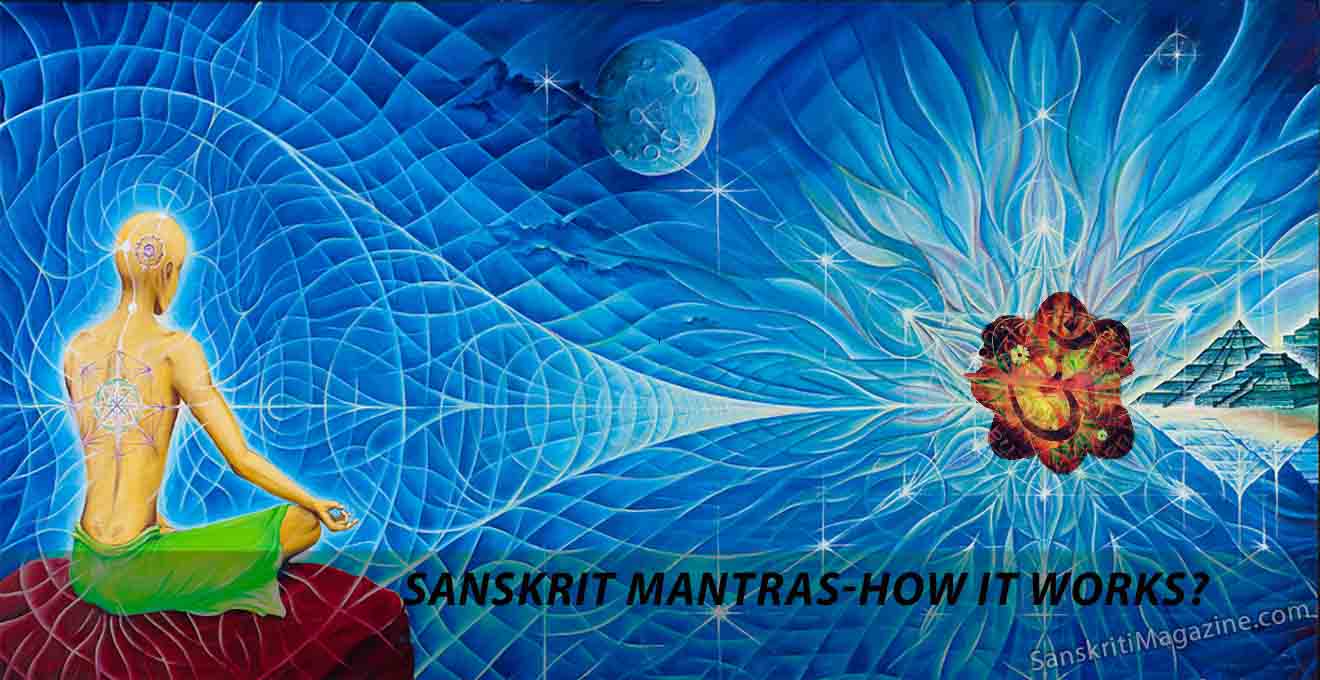Anyone familiar with the great epics of Ramayana and Mahabharata can clearly notice that martial arts and various combat displays have been vital to the history and cultures of South Asia since ancient times.
In Bhagavad-Gita, Krishna’s discourse to Arjun focuses on a Kshatriya’s action and his duty to take up arms for righteousness, even against his own relatives. In both the epics, there are elaborate details on the acquisition, the use of their skills and powers acquired by the heroes both by human or divine methods to defeat their enemies. They accomplished perfection of these martial techniques under the tutelage of great gurus like Dronacharya and also practicing and perfecting austerities and meditation techniques. Part of their skills also included magical powers received as a gift or a boon from a god or divine powers.
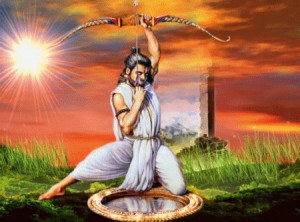 Several different types of martial arts mastery co-existed side-by-side. The epics showcase Arjuna making use of his accomplishments in single-point focus or with powers acquired through meditation. In stark contrast to this, Bhima depended on sheer brute strength to crush his foes.
Several different types of martial arts mastery co-existed side-by-side. The epics showcase Arjuna making use of his accomplishments in single-point focus or with powers acquired through meditation. In stark contrast to this, Bhima depended on sheer brute strength to crush his foes.
Of all the warfare tactics, the Dhanurveda was considered to be the highest or best amongst the various weapons traditionally practiced by martial artists in ancient India. The word Dhanurveda in Sanskrit literally means science (veda) of archery (dhanus).
“Battles [fought] with bows [and arrows] are excellent, those with darts are mediocre, those with swords are inferior and those fought with hands are still inferior to them” (Gangadharan, 1985, 645).
The earliest surviving text on dhanurveda is a collection of chapters in the encyclopedic “Agnipurana” that has been dated to 8th Century CE. However, several historians such as G.N. Pant have argued that the earliest versions of a dhanurveda text dates from the period prior to or at least contemporary with the epics (c. 1200–600 BCE; Pant, 1978, 3–5; Chakravarti, 1972, x). Dhanurveda has been described as one of the traditional 18 branches of knowledge in the Vishnupurana.
“Elsewhere, [Dhanurveda] is said to be an Upaveda of Yajurveda, ‘by which one can be proficient in fighting, the use of arms and weapons and the use of battle-arrays …’ Further, it is described as having a sūtra like other Vedas, and as consisting of four branches (catuspāda) and ten divisions (daśavidha)” (Chakravarti, 1972, x).
The chapters found in Agnipurana emphasize on a wide range of techniques and instructions geared towards the king preparing for war whose sole focus is on training his soldiers in arms. These four chapters appear to be an edited version of earlier manuals on the subject of dhanurveda. The later version of Brats Sarngadhara Paddhati, a 15th Century treatise in Sanskrit on the “Science of Horn Blow” is a far more comprehensive book than the Agnipurana, elaborating further on the art of dhanurveda.
“This book contains ideas of people who are masters at bow and arrow. With practice one becomes an expert and can kill enemies” (BrSrPad. 1717; trans. Pant, 1978).
These four chapters focus primarily on how the martial artist trains both his mind and body in use of the most “excellent” bow and arrow. Elsewhere in the Agnipurāna, disparate passages include information on:
- Rituals performed by Brahman priests to protect and/or cause success in battle (Dutt Shastri, 1967, 539, 840),
- Construction of forts (Shastri, 1985, 576–578),
- Instructions for military expeditions (Shastri, 1985, 594), and
- Battle formations and troop deployments (Shastri, 1985, 612–615, 629–635).
The chapters provide both sacred knowledge (paravidya) and profane knowledge (aparavidya) of the subject. Initial pages catalogue the subject, providing five training divisions for warriors on:
- Chariots
- Elephants
- Horseback
- Infantry, and
- Wrestling
There are five types of weapons to be learned that were:
- Projected by machines (arrows or missiles)
- Thrown by hand (spears)
- Cast by hands yet retained (noose)
- Permanently held in the hands (sword) and the hands themselves
The book states that it was the birthright of a Brahman or a Kshatriya to teach dhanurveda to others. The Sudras and people of “mixed castes” could also be called upon by the King to take arms when necessary if they had acquired a general proficiency in the art of warfare by regular training and practice. (AgP. 249.6–8; Dutt Shastri, 1967, 894–895).
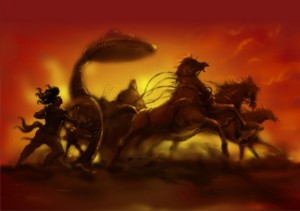 Training in the book starts with the noblest of weapons of bow and arrow, focusing on the specifics of training and practice. It provides the names and describes ten basic lower-body poses to be assumed when using bow and arrow and the specific posture to assume when the disciple pays obeisance to his preceptor (AgP. 249.9–19). Once the basic positions have been described, the manual records technical instructions on how to string, draw, raise, aim, and release the bow and arrow, and it catalogues types of bows and arrows (AgP. 249.20–29).
Training in the book starts with the noblest of weapons of bow and arrow, focusing on the specifics of training and practice. It provides the names and describes ten basic lower-body poses to be assumed when using bow and arrow and the specific posture to assume when the disciple pays obeisance to his preceptor (AgP. 249.9–19). Once the basic positions have been described, the manual records technical instructions on how to string, draw, raise, aim, and release the bow and arrow, and it catalogues types of bows and arrows (AgP. 249.20–29).
Second chapter records the more advanced and difficult bow-and-arrow techniques as well as ritual purification of the weapons before they are used. It also discusses the importance of the martial artist achieving the type of subtle state of interior mental accomplishment necessary to become a skilled master. When the archer has become so well practiced that he “knows the procedure,” he is instructed to “fix his mind on the target” before releasing the arrow (Shastri, 1985, 648).
Having achieved the ability to fix his mind, the archer’s training is still not complete. The archer must apply this ability while performing increasingly difficult techniques, such as hitting targets above and below the line of vision, vertically above the head, and while riding a horse; hitting targets farther and farther away; and finally hitting whirling, moving, or fixed targets one after the other (AgP. 250.13–19). The chapter concludes with a summary state of the accomplished abilities of the archer:
“Having learned all these ways, one who knows the system of karma-yoga [associated with this practice] should perform this way of doing things with his mind, eyes, and inner vision since one who knows [this] yoga will conquer even the god of death” (Dasgupta, 1986).
Conquering the “god of death” is akin to conquering the self and overcoming all obstacles, whether physical, mental or emotional but it is not the final training for the archer.
“Having acquired control of the hands, mind, and vision, and become accomplished in target practice, then [through this] you will achieve disciplined accomplishment (siddhi)” (Dasgupta, 1986).
Remainder of the last two chapters focus on postures and techniques for using a variety of other weapons such as:
- Noose
- Swords
- Armors
- Iron dart
- Club
- Battle axe
- Discus
- Trident, and
- Wrestling
The end of final chapter concerns with the use of war elephants and men, concluding with a description of how to send off the fighter to war:
“The man who goes to war after worshipping his weapons and the Trailokyamohan Sastra [one which pleases the three worlds] with his own mantra [given to him by his preceptor], will conquer his enemy and protect the world” (Dasgupta, 1986).
The dhanurvedic tradition was a highly developed system of training through which the martial practitioner was able to achieve a state of ideal perfection and superior self-control, mental calm, single-point concentration and access to special powers in the use of combat weapons. These traits can still be seen today in martial arts such as Kalarippayattu and Manipuri Thangta.
Tamil Martial Arts:
From 4th Century BCE to 600 CE, martial arts predominated across Southern India. During this era, the three kingdoms of Chera, Chola and Pandiya were at a constant struggle for supremacy and domination.
In the Puranānūru (Four Hundred Poems on War) the poetess Ponamutiyār wrote concerning the young warriors of the period,”it is my prime duty to bear and bring him up, it is his father’s duty to make him a virtuous man … it is the duty of the blacksmith to provide him with a lance; it is the duty of the king to teach him how to conduct himself (in war). It is the son’s duty to destroy the elephants and win the battle of the shining swords and return (victorious)” (Subramanian, 1966, 127).
The heroes of this period were noble ones whose main pursuit was fighting with their greatest honour of dying a battlefield death; war was considered a sacrifice of honour and memorials erected for the fallen king, soldiers and their horses.
Power Play of Ancient India:
What is implicit in both early Tamil and Sanskrit sources is the view that combat is not simply a test of overt strength and/or will between two human beings like modern sport boxing, but rather is a contest between a host of complex, contingent, unstable, and immanent “powers” to which each combatant gains access through a variety of means:
- by attaining mastery of a particular technique or weapon through long-term
- practice under the guidance of a guru ;
- by attaining accomplishment (siddhi) in specific meditation techniques giving the practitioner “mental power”;
- by attaining accomplishment in specific mantra that unlocks specific special powers; and/or
- by attaining “power” through a divine gift.
The agency and power of the martial artist in Indian antiquity must be understood as a complex set of interactions between humanly acquired techniques of virtuosity (the human microcosm) and the divine macrocosm.
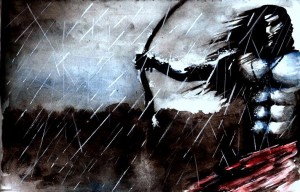 Unlike today’s commonplace assumptions that any type of power (electricity, gravity, etc.) is stable and therefore measurable and quantifiable, “power” was until recently considered unstable, capricious, and locally immanent. Given this instability, the martial practitioner accumulated numerous different “powers” through any/all means at his disposal, depending not only on his own humanly acquired skills achieved under the guidance of his teacher(s), but also on the acquisition of powers through magico-religious techniques such as repetition of mantra.
Unlike today’s commonplace assumptions that any type of power (electricity, gravity, etc.) is stable and therefore measurable and quantifiable, “power” was until recently considered unstable, capricious, and locally immanent. Given this instability, the martial practitioner accumulated numerous different “powers” through any/all means at his disposal, depending not only on his own humanly acquired skills achieved under the guidance of his teacher(s), but also on the acquisition of powers through magico-religious techniques such as repetition of mantra.
The epic literature reflects this complex interplay between divinely gifted and humanly acquired powers for the martial practitioners of antiquity that is clearly part of the dhanurvedic tradition. One example is the playwright Bhāsa’s version of Karna’s story, Karnabhāra (The Burden of Karna), which illustrates the divine gift of power (śakti) that requires no attainment on the part of the practitioner. Indra, disguised as a Brahman, has come to Karna on his way to do combat with the Pāndavas. As a Brahman, Indra begs a gift from Karna.
Karna freely offers gift after great gift, all of which are refused. Finally, against the advice of his charioteer Śalya, he offers that which provides him as a fighter with magical protection – his body armor, which cannot be pierced by gods or demons, and his earrings. Indra joyfully takes them. Moments later a divine messenger informs Karna that Indra is filled with remorse for having stripped him of his protection.
The messenger asks Karna to “accept this unfailing weapon, whose śakti is named Vimalā, to slay one among the Pāndavas” (KarBh. 102; Dasgupta, 1986). At first Karna refuses, saying that he never accepts anything in return for a gift; however, since this gift is offered by a Brahman, he agrees to accept it. As he takes the weapon from the messenger, he asks, “When shall I gain its power (śakti)?” and the messenger responds, “When you take it in [your] mind, you will [immediately] gain its power” (KarBh. 105–106; Dasgupta, 1986). Unlike the powers gained through practice and repetition of exercises or austerities, here Karna is a vehicle of divine power that simply requires that he “take [the weapon] in mind” for its specific power to be at his disposal.
A more complex set of circumstances is at play in the story of Arjuna and the pāśupata weapon, recorded in the Āranyakaparvan (The Book of the Forest) of the Mahābhārata (MBh. 38.1–42.1; trans. Van Buitenen, 1975, 296–303).
His mastery of the weapon requires much more of him than simply accepting the weapon as a gift. Yudhisthira knows that, should combat come, the Kauravas have gained access to “the entire art of archery,” including “Brahmic, Divine, and Demonic use of all types of arrows, along with practices and cures.” The “entire earth is subject to Duryodhana” due to this extraordinary accumulation of powers. Yudhisthira, therefore, calls upon Arjuna to go and gain access to still higher powers than those possessed by the Kauravas.
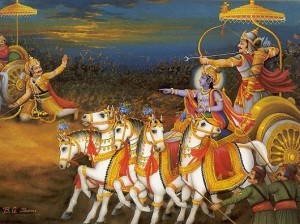 Yudhisthira is prepared to send Arjuna to Indra, who possesses “all the weapons of the Gods.” But to gain access to Indra, Yudhisthira must teach Arjuna the “secret knowledge,” which he learned from Dvaipāyana and which will make the entire universe visible to him. After Arjuna is ritually purified to win divine protection and once “controlled in word, body, and thought,” he meets Indra in the form of a blazing ascetic who attempts to dissuade him from his task; however, he is not “moved from his resolve” and requests that he learn from Indra “all the weapons that exist.” Indra sends Arjuna on a quest – he can receive such knowledge only after he has found “the Lord of the Beings, three-eyes, trident-bearing Śiva.”
Yudhisthira is prepared to send Arjuna to Indra, who possesses “all the weapons of the Gods.” But to gain access to Indra, Yudhisthira must teach Arjuna the “secret knowledge,” which he learned from Dvaipāyana and which will make the entire universe visible to him. After Arjuna is ritually purified to win divine protection and once “controlled in word, body, and thought,” he meets Indra in the form of a blazing ascetic who attempts to dissuade him from his task; however, he is not “moved from his resolve” and requests that he learn from Indra “all the weapons that exist.” Indra sends Arjuna on a quest – he can receive such knowledge only after he has found “the Lord of the Beings, three-eyes, trident-bearing Śiva.”
Setting out on his journey “with a steady mind,” he travels to the peaks of the Himalayas, where he settles to practice “awesome austerities.” Eventually Śiva comes to test him in the form of a hunter. After a prolonged fight with bows, swords, trees, rocks, and fists, Śiva subdues Arjuna when he “loses control of his body.” Śiva then reveals his true form to Arjuna, who prostrates before him. Śiva recognizes that “no mortal is your equal” and offers to grant him a wish. Arjuna requests the pāśupata – the divine weapon.
Śiva agrees to give him this unusual weapon, which is so great that “no one in all the three worlds (the Brahmic, Divine, and Demonic) . . . is invulnerable to it.”
To gain access to the weapon’s awesome power, Arjuna must first undergo ritual purification, prostrate himself in devotion before Lord Śiva and embrace his feet, and then learn its special techniques. Śiva instructs him in the techniques specific to the pāśupata, and having become accomplished in these, he also learns “the secrets of its return.”
As illustrated in this and other stories, among all the martial heroes of the epics, Arjuna is the perfect royal sage, possessing the ideal combination of martial and ascetic skills, and able to marshal the various powers at his command as and when necessary. Arjuna is able to attain the awesome power of the pāśupata because of his extraordinary “steadiness of mind,” his superior skills at archery, and his ability to undergo “awesome” austerities.

